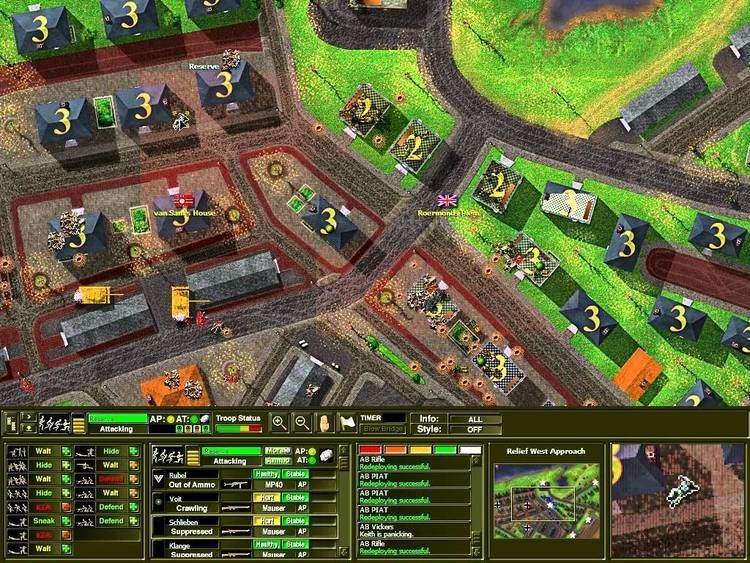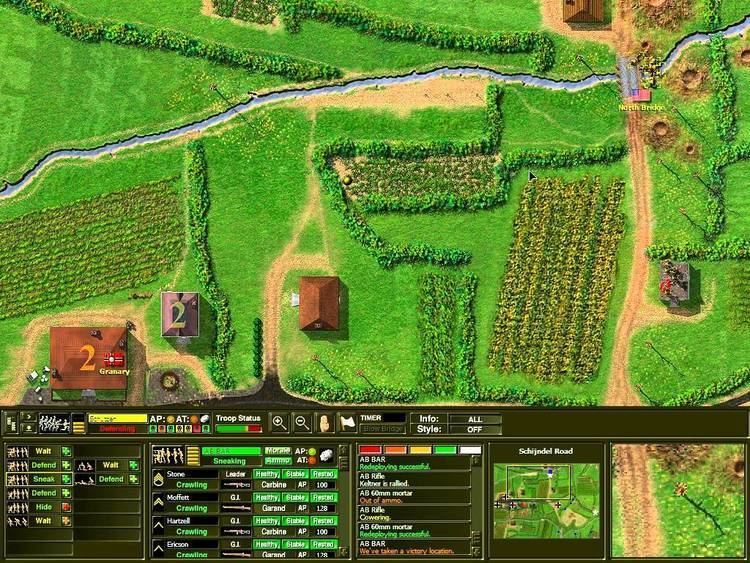9 /10 1 Votes9
9.1/10 GameSpot Initial release date 1997 Genre Real-time tactics | 4.5/5 My Abandonware Release date(s) September 30, 1997 | |||||||||||||||||||||||||||||||||
 | ||||||||||||||||||||||||||||||||||
Mode(s) Single player, multiplayer Similar Close Combat games, Atomic games, Real-time tactics games | ||||||||||||||||||||||||||||||||||
Close Combat: A Bridge Too Far, or Close Combat II, is a World War II real-time tactics game, developed by Atomic Games, and released on September 30, 1997. The second installment of the Close Combat series, the game is played on a two-dimensional map, between two players.
Contents
- Gameplay
- Forces
- Gameplay modes
- Battle
- Operation
- Sector Campaign
- Grand Campaign
- Critical reception
- References

Close Combat is based on Operation Market Garden; most units in the game are based on those used in 1944, with the exception of a few which are only available in custom games. The game may be played as either the Germans, or the Allies, the latter divided into the British, Americans, and Polish. The game received mainly positive reviews.

Gameplay

Combat takes place on a two-dimensional map with three-dimensional terrain elements. Depending on the map, terrain features can include a variety of features providing concealment and cover, such as hills, hedges, foxholes, trenches, streams and buildings. Units have limited fields of vision (particularly vehicles), suffer from fatigue, have limited ammunition, can be suppressed, will break and flee if their morale drops too low, and generally behave in a manner similar to real life (although there are options to make units always visible, always obey orders, and/or fearless).

The units used in the game vary, but are nonetheless divided into two categories: infantry, and support. The infantry category contains most infantry units, such as rifle infantry, scouts, snipers, MG42 machine gunners (for the German side), antitank infantry (for the Allied side), heavy assault teams, and reserves. More specialized infantry teams such as flamethrower engineers, mortar teams and machine gun teams are placed in the support category, as are vehicles (including halftracks, armored cars, tanks, tank destroyers and assault guns) and fixed guns.
Forces
There are four main forces in the game:
The sides vary in equipment (except for the Poles, who use a reduced selection of British equipment). Generally, US and German infantry squads are larger than their British/Polish counterparts.
Gameplay modes
The player can choose to play a single battle, or a longer operation or campaign made up of multiple battles.
Battle
The "battle" depicts a single one-day engagement, such as the taking of the Arnhem rail bridge (Battle of Arnhem). Battles are played in a single seating, and usually last several minutes. Units are assigned to each player at the start of the battle, and cannot be changed. The objective of each battle is usually for the Allies to take victory locations dotted around the map, and the Germans to hold those locations (although this can vary with the map). Sometimes, the Allies may have to secure a bridge (by forcing the Germans off the map) before the Germans can destroy it. Declaring a ceasefire or retreating from the battle immediately ends it.
Operation
Operations are made up of a series of battles (up to five), and depict an operation spanning several days in a specific locale (such as the offensive at the Arnhem Bridge). The overall objective of each side is to control the maps in the operation, with each map having a certain point value:
If the player fails to win the entire map, he/she still receives points based on the number and value of victory locations controlled. The victory level at the end of the operation is based on the sum of victory points accumulated at the end of each day.
Unlike battles, in an operation the players can customize their force before each battle by purchasing units before each battle, using requisition points (obtained over time as a result of receiving supplies). Up to nine infantry units and six support units may be brought into a single battle. A unit that takes losses will be eventually replenished (although it may be better to simply remove that unit and requisition a new one).
Additionally, both sides can declare a ceasefire, which stops the battle for one to seven hours while both sides recuperate. A badly beaten force can also choose to flee from the battle, although this can result in engaged units being captured by the enemy, or even (if the map is the last one in the operation controlled by the retreating side) result in the operation being canceled.
Sector Campaign
The sector campaign offers a larger scope of combat than the operation or battle. Sector campaigns take place in one of the three sectors: Arnhem, Nijmegen, or Eindhoven. Each sector campaign consists of a number of operations fought in parallel (thus, rather than playing an entire operation and moving on to the next one, the player will be fighting battles in multiple operations at once).
The objective in each sector campaign is similar that of the operation; that is, to take and hold maps. The victory rating for the Arnhem sector campaign is based on how well British and Polish forces are holding out at the end of the campaign (compared to the historical outcome of the real-life campaign), while that of the Nijmegen and Eindhoven sector campaigns is based on how quickly XXX Corps can advance through that sector (likewise).
If the Germans can seize the landing zones, they will be able to prevent the Allied airborne units from receiving supplies. Moreover, they can delay XXX Corps's progress by attacking a road or bridge after it has already passed that location.
Grand Campaign
The Grand Campaign is the largest in scope of all the gameplay modes, and offers the most strategy. It combines all three Sector Campaigns into a single campaign, depicting the events of Operation Market Garden starting from September 17, 1944. The ultimate objective is Arnhem, particularly the road bridge.
At the end of each day, both players must choose a sector to supply (other sectors will also be supplied, but not as much). German forces can receive supplies by land at any time, while Allied forces can only be resupplied by land in areas which XXX Corps has already relieved. Additionally, the Allied player can also airdrop supplies into any sector (unless the Germans control the landing zones).
Victory is determined based on how fast XXX Corps reaches Arnhem (or if they even arrive at all), and how much ground 1st Airborne has managed to hold when reinforcements arrive.
Critical reception
In an interview with IGN, Keith Zabalaoui, the President of Atomic Games in 1999, was asked about the sales of Close Combat. He noted that "Worldwide sell-through of Close Combat I and Close Combat II has been around 200,000 units for each game. That tops sales of our previous games by a factor of about ten. So, yes, we're very pleased with the sales."
Notable awards received by this game include: coming seventh in GameSpy's "Top Ten Real-Time Strategy Games of All Time", editor's choice from PC Gamer, and runner up as the best wargame of the year, by PC Gamer.
